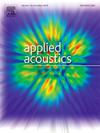The effects of the interaction between sewage odour and sounds on crowd behaviours in urban waterfront park
IF 3.4
2区 物理与天体物理
Q1 ACOUSTICS
引用次数: 0
Abstract
Sewage odour is a common pollution odour source produced by urban water bodies and negatively impacts people’s behaviour. This study aimed to explore whether sound could change this negative effect. Therefore, a behaviour-observation experiment was conducted in a typical urban waterfront park using the sewage odour as the source of the pollution smell and playing typical sound sources in urban environments (music and fan sounds) with and without odour. The results showed that for crowd paths, music could significantly attract a crowd, fan sound or sewage odour could keep the crowd away. Furthermore, when there was sewage odour, the effects of the trends of approaching or receding from the sound sources caused by the music and fan sounds, respectively, have been strengthened. Sound and odour had relatively independent impacts on the crowd speed and duration time, reflected in the fact that music significantly reduced the crowd speed whereas fan sound and sewage odour significantly improved it. Music significantly increased the crowd duration time, while fan sound and sewage odour significantly reduced it. On this basis, the independent effects of sound and odour were superimposed, and the positive effect of music was stronger than the negative effect of sewage odour.
污水气味与声音的相互作用对城市海滨公园人群行为的影响
污水气味是城市水体产生的一种常见污染气味源,会对人们的行为产生负面影响。本研究旨在探讨声音能否改变这种负面影响。因此,我们在一个典型的城市滨水公园进行了行为观察实验,以污水气味作为污染气味源,并在有气味和无气味的情况下播放城市环境中的典型声源(音乐和风扇声)。结果表明,对于人群路径,音乐能明显吸引人群,而风扇声或污水气味则能使人群远离。此外,当有污水气味时,由音乐和风扇声分别引起的接近声源或远离声源的趋势的影响得到了加强。声音和气味对人群速度和持续时间的影响相对独立,这体现在音乐显著降低了人群速度,而风扇声和污水气味则显著提高了人群速度。音乐明显增加了人群持续时间,而风扇声和污水气味则明显减少了人群持续时间。在此基础上,声音和气味的独立效应叠加,音乐的积极效应强于污水气味的消极效应。
本文章由计算机程序翻译,如有差异,请以英文原文为准。
求助全文
约1分钟内获得全文
求助全文
来源期刊

Applied Acoustics
物理-声学
CiteScore
7.40
自引率
11.80%
发文量
618
审稿时长
7.5 months
期刊介绍:
Since its launch in 1968, Applied Acoustics has been publishing high quality research papers providing state-of-the-art coverage of research findings for engineers and scientists involved in applications of acoustics in the widest sense.
Applied Acoustics looks not only at recent developments in the understanding of acoustics but also at ways of exploiting that understanding. The Journal aims to encourage the exchange of practical experience through publication and in so doing creates a fund of technological information that can be used for solving related problems. The presentation of information in graphical or tabular form is especially encouraged. If a report of a mathematical development is a necessary part of a paper it is important to ensure that it is there only as an integral part of a practical solution to a problem and is supported by data. Applied Acoustics encourages the exchange of practical experience in the following ways: • Complete Papers • Short Technical Notes • Review Articles; and thereby provides a wealth of technological information that can be used to solve related problems.
Manuscripts that address all fields of applications of acoustics ranging from medicine and NDT to the environment and buildings are welcome.
 求助内容:
求助内容: 应助结果提醒方式:
应助结果提醒方式:


